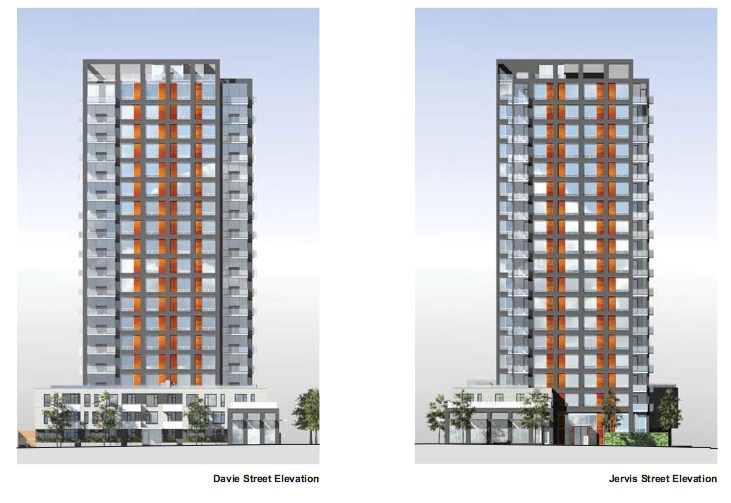A May 4th tweet under the @CityHallWchVan handle created a firestorm this week by calling attention to a new West End condominium project that features a separate door for the social housing units — a so-called “poor door.”
'Poor doors' in proposed West End tower. More #SegregatedCondos to follow elsewhere in #Vancouver? #dtes #marpole pic.twitter.com/VFDTctuOvH
— CityHallWatch (@CityHallWchVAN) May 4, 2015
Later that day, the Development Permit Board approved the 19-storey condominium project at 1177 Jervis St. (now 1171 Jervis), which will feature 62 market residential units, 27 social housing units and commercial space at ground level.
But the debate about the doors hasn’t stopped even though Brian Jackson, the city’s head planner, told the Courier Tuesday that no one spoke against the project at the DPB meeting Monday, and no one brought up the “poor door.” One person spoke in favour of the project.
So-called poor doors have been controversial in New York City. Critics panned a new tower that included different entrances for condo owners and low-income tenants, although ultimately 88,000 people applied for the 55 low-priced units, according to the New York Times.
Jackson said in the Jervis Street case the door to the social housing is more prominent than the door to the condo.
“It’s ironic in this particular instance because the front door for the social housing is on Davie Street. The front door for the condo is on a side street. So it’s actually the condo that has the poor door,” he said. “The developer did not hide the door, it’s not off a lane or anything. It’s actually on the main street.”
When asked if separate entrances are typical, Jackson said: “I’ve seen it done both ways. In these types of projects where we’re asking for [social housing] to be included in the condominium development, the developers are telling us, for marketing purposes, they would prefer that. But we will not accept an entrance off of a lane. We will not accept an entrance that is not equally prominent as the other door.”
Jackson added that the social housing on the site will be owned by the city, so it’s a separate air space parcel.
“So a lot of it has to do with the design of the building itself in terms of where the door is and whether they can be combined. It is difficult when the city is going to have ownership of a parcel for the entrances to be combined because of the legality of the separate legal lot that exists for the city social housing,” he said. “It’s difficult but you can have easements over each other’s lots to have a shared entrance but it becomes problematic.”
Separate doors for social housing is not a new concept in Vancouver. Long-time housing activist Jean Swanson calls the idea “elitist.”
“It shows a kind of hypocrisy because people use the rhetoric around social mix to justify gentrifying poor neighbourhoods like the Downtown Eastside and then when they actually put in the buildings like Woodward’s, which are ostensibly socially mixed, they have a poor door and a rich door, and they have a poor amenity and then they have a rich amenity with the W-shaped hot tub,” she said. “So it’s a class thing. It shows how divided our society is by class. And it shows how hypocritical the concept of social mix is because there is no mixing.”
Swanson argues that if separate doors weren’t permitted, it would reflect a more equal society. She said the idea developers can market a project more easily if there are separate doors reveals the prejudice that exists against low-income people.
“It would be way better if that prejudice didn’t exist and if developers didn’t pander to it,” she said. “If the powers that be — the developers, the city, whatever — wanted to challenge the stereotyping and discrimination against renters and low-income people, they could think of a way to do it.”
Randy Helten, who shares the CityHallWatch twitter handle with other activists, said Wednesday he didn’t personally post the tweet, but he’s done about 10 interviews about the subject over the past 24 hours.
“I think this means that our society believes in the importance of equality and the image of having separate doors based on your level of affluence is unacceptable to a large number of people,” he said. “The term [poor door] triggered the outrage.”
Even though separate entrances are not new, he said one of the problems is the public doesn’t know how prevalent they are since only a couple of examples such as the Woodward’s building have been brought forward and the city has said it’s not keeping track.
“I think the majority of the public has no idea that there are segregated doors,” said Helten who added he doesn’t like the term ‘poor door.’ “I know of other fresh projects in which there are affordable income rentals and luxury condos and they use the same lobby and elevator.”
He cited the Alexandra building at Bidwell and Davie, which was completed about two years ago.
“So contrary to what some of the experts have been saying — that this is the norm — I don’t think anyone has proven that it is the norm yet.”
Helten maintains the issue needs to be discussed given the growing disparity between the rich and the poor around the world and, as house prices continue to skyrocket in Vancouver, the separation of entrances may become more prevalent.
“We’re talking about the physical infrastructure of our society. A tower that’s going up now will probably be standing for four generations or more and we’re building into our architecture a distinction of people in the same building based on their economic status,” he said.



